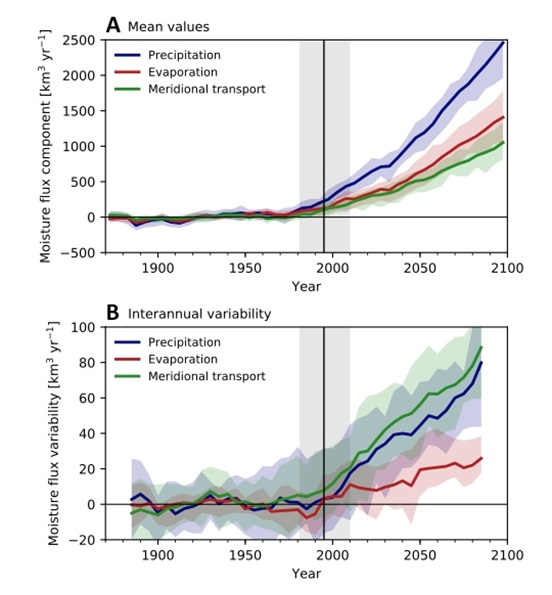Jaar tot jaar variaties in Arctische neerslag nemen sterk toe
Recent wetenschappelijk onderzoek laat zien dat er gemiddeld genomen meer neerslag zal gaan vallen in het Noordpoolgebied vanwege de klimaatopwarming; eerst vooral sneeuw en bij verdere opwarming regen. In een nieuw artikel van RUG-klimaatonderzoeker prof. dr. Richard Bintanja samen met collega’s van het KNMI, Wageningen University and Research en de TU Delft dat in Science Advances is gepubliceerd, blijkt dat ook de jaar tot jaar variaties sterk zullen toenemen. En dat deze toename bovendien een heel andere reden heeft dan de gemiddelde stijging in Arctische neerslag.
Jaar tot jaar fluctuaties zijn van groot belang voor extremen in weer en klimaat, en dus voor de gevolgen van klimaatverandering. Een bijzonder nat/droog/koud of warm jaar heeft doorgaans veel verstrekkender gevolgen dan een aantal opeenvolgende 'gewone' jaren. In het Noordpoolgebied zijn alle klimaatveranderingen, dus ook die in variabiliteit, veel groter dan in de rest van de wereld, waarbij de mogelijke gevolgen hiervan in zowel de Arctic als in de gematigde breedtes voelbaar zullen zijn.
Vochttransport
Het onderzoek toont op basis van de nieuwste klimaatmodellen aan dat toekomstige fluctuaties in neerslag zeer sterk zullen toenemen, en dat dit wordt veroorzaakt door het atmosferisch vochttransport naar het Noordpoolgebied. Dit is in sterke tegenstelling tot de toename in de gemiddelde neerslag, die vooral het gevolg is van toegenomen verdamping en zee-ijsafname in de Arctic zelf. Opvallend genoeg worden veranderingen in de gemiddelde neerslag dus bepaald door lokale processen in het Noordpoolgebied, terwijl de toename in de fluctuaties via atmosferische processen vanuit lagere breedtes wordt aangedreven.
Meer en nattere jaren
Richard Bintanja: “Op basis van deze opvallende resultaten concluderen wij dat de natte jaren in het Noordpoolgebied in de toekomst veel natter zullen worden. Dit wordt niet alleen veroorzaakt door de gemiddelde stijging in de neerslag, maar vooral ook door de sterke toename in de jaar tot jaar variaties.” Overigens zijn de toekomstige veranderingen in klimaatvariabiliteit minder zeker dan die in het gemiddelde klimaat. “Hoewel in nagenoeg alle klimaatmodellen de neerslagvariabiliteit in het Arctische gebied toeneemt, is de mate waarin dat gebeurt sterk modelafhankelijk.”

Meer nieuws
-
02 december 2025
Student Menna Zahran wint Unilever Research Prize
-
27 november 2025
Vliegtuigen spotten met een radiotelescoop
